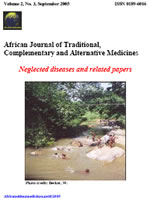
|
African Journal of Traditional, Complementary and Alternative Medicines
African Ethnomedicines Network
ISSN: 0189-6016
Vol. 11, No. 2, 2014, pp. 339-342
|
 Bioline Code: tc14054
Bioline Code: tc14054
Full paper language: English
Document type: Short Communication
Document available free of charge
|
|
|
African Journal of Traditional, Complementary and Alternative Medicines, Vol. 11, No. 2, 2014, pp. 339-342
| en |
IRON DEFICIENCY ANAEMIA IN REPRODUCTIVE AGE WOMEN ATTENDING OBSTETRICS AND GYNECOLOGY OUTPATIENT OF UNIVERSITY HEALTH CENTRE IN AL-AHSA, SAUDI ARABIA
Taha, Asia; Azhar, Saira; Lone, Talib; Murtaza, Ghulam; Khan, Shujaat Ali; Mumtaz, Amara; Asad, Muhammad Hassham Hassan Bin; Kousar, Rozina; Karim, Sabiha; Tariq, Imran; ul Hassan, Syed Saeed & Hussain, Izhar
Abstract
Background: Iron deficiency is the most common nutritional disorder in the world. The aim of this questionnaire based survey study was to
determine the prevalence of iron deficiency anemia in reproductive age women, and their relation to variables such as age, marital status,
education with those attending obstetrics and gynecology outpatient of King Faisal University Health Centre in Al-Ahsa in eastern region of
Kingdom of Saudi Arabia.
Materials and Methods: This study was conducted for the period of 6 month staring from September 2012 to
February 2013. The questionnaire had three sections on personal information: their educational indicators, gynecological clinical history, and
hematological indices.
Results: The average age was 25.97±7.17 years. According to the gynecological clinical history of the respondents, 15 (48.4%) respondents were
pregnant while 16 (51.6%) were not pregnant. There was significant effect of pregnancy status on Hb level. Majority of the anemic respondents
15/17 were married. Moreover 14/17 anemic women were experiencing severe menstrual bleeding, 11/17 respondents were pregnant. 54.8% of
respondents were hemoglobin deficient while 77.4% were found to have low Hct. In 87.1 % of the respondents, transferrin saturation was found
to be abnormal.
Conclusion: In this study iron deficiency anemia is quite prevalent in the university community especially among pregnant women. The fetus’s
and newborn infant’s iron status depends on the iron status of the pregnant woman and therefore, iron deficiency in the mother-to-be means that
growing fetus probably will be iron deficient as well. Thus iron deficiency anemia during pregnancy in well-educated set up needs more attention
by the concerned authorities.
Keywords
Iron deficiency Anemia (IDA); Hemoglobin; Female; Reproductive Age
|
| |
© Copyright 2014 - African Journal of Traditional, Complementary and Alternative Medicines
Alternative site location: http://journals.sfu.ca/africanem/index.php/ajtcam
|
|
